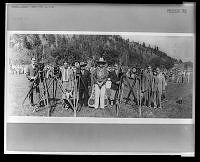Coolidge on Vacation in Black Hills, South Dakota
This photograph was taken during President Calvin Coolidge's vacation in Black Hills, South Dakota in the summer of 1927. Coolidge stands in the center of the photograph dressed as a cowboy, flanked on both sides by press photographers. The president received the Western-style hat and cowboy boots as gifts during his tour. Coolidge chose to vacation in the Black Hills following a campaign by South Dakotans designed to appeal to the president's love of trout fishing. The president's visit brought a boon to the tourism and infrastructure to the area. During his vacation, Coolidge delivered remarks at the dedication of the start of work on the Mount Rushmore National Memorial and visited Pine Ridge, a tribal reservation of the Lakota people.








